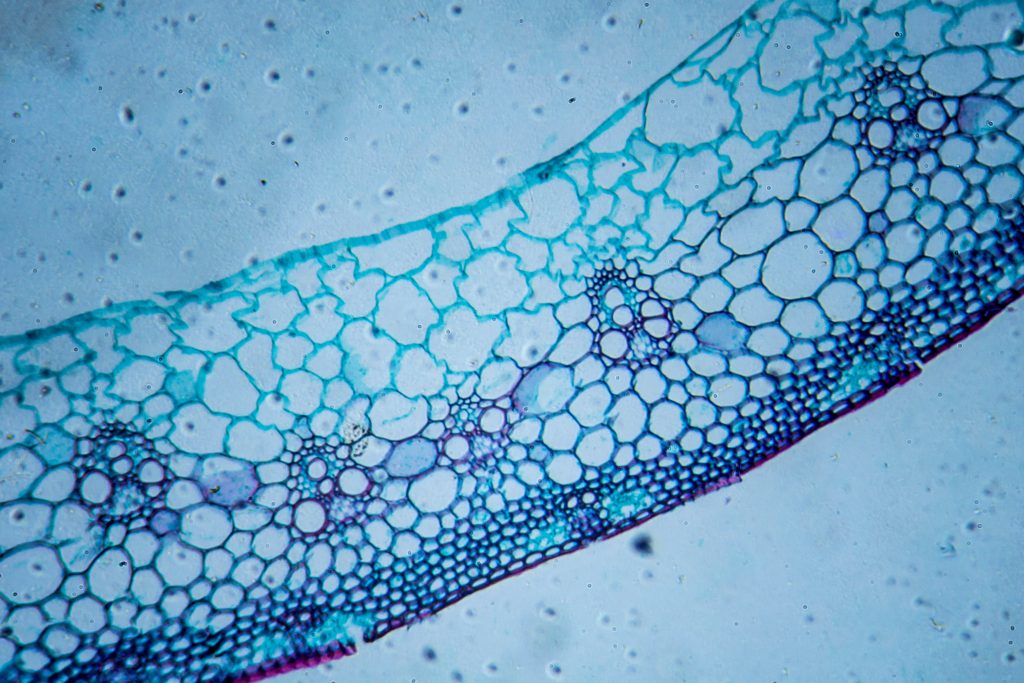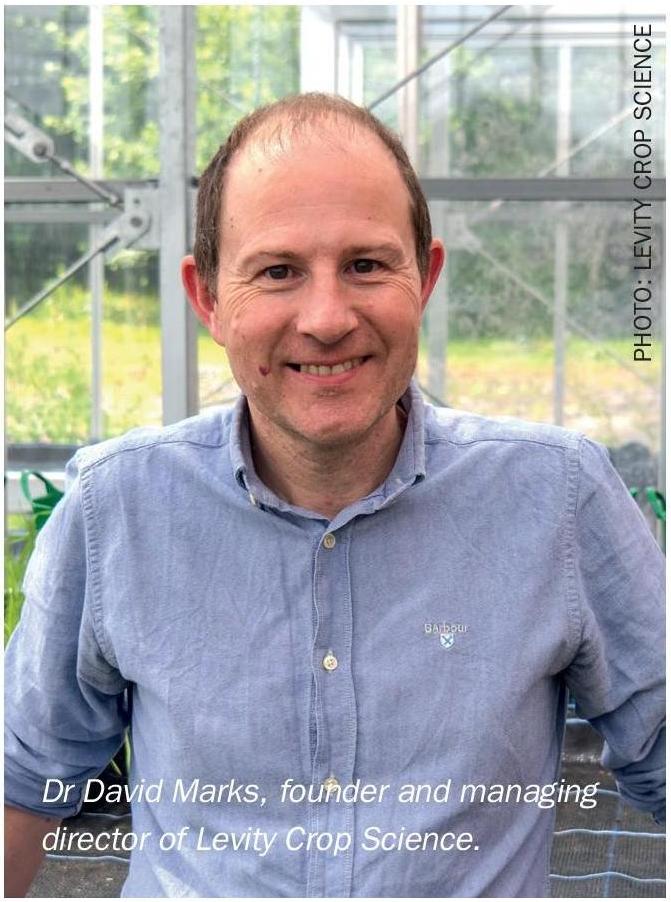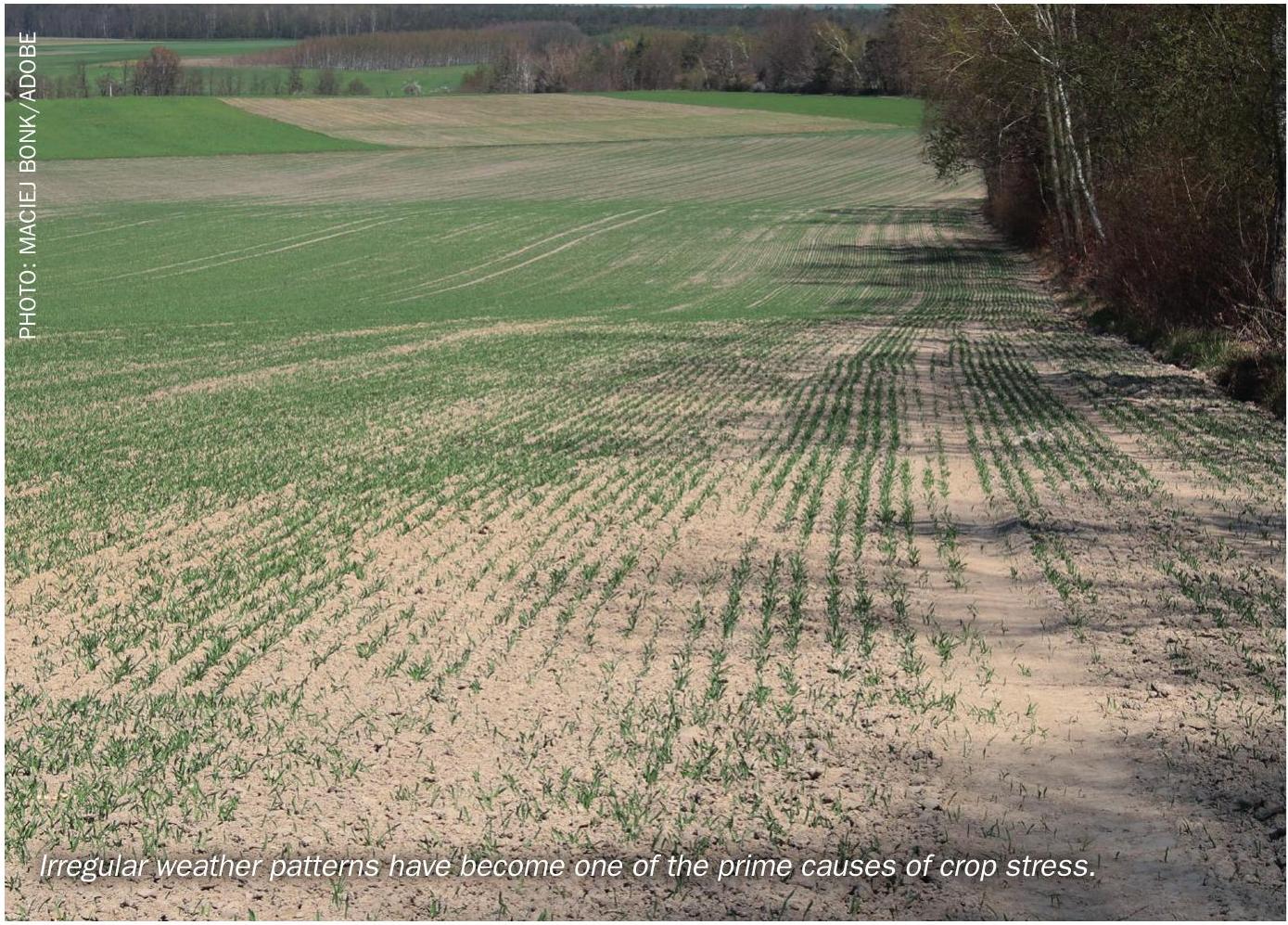Fertilizer International 527 Jul-Aug 2025

7 July 2025
Stressing out with Indra
PRODUCT INNOVATION
Stressing out with Indra
Levity Crop Science has made alleviation of crop stress the goal of its latest innovation. Its founder Dr David Marks talks to Fertilizer International about Levity’s new product, Indra, and the company’s innovative approach to crop stress, a major side effect of variable and extreme weather.

With Indra, Levity has created a formulation that instructs the plant to produce polyamines. These can act as a substitute for calcium in the cell wall (in this instance wheat).
Crop stress – the next challenge?
“Has incidence of crop stress increased in recent years?” asks Dr David Marks, the managing director and founder of British functional fertilizer company Levity Crop Science. “Of course, we don’t know, there are no reliable figures. But I think it’s fair to say growers and agronomists have become more aware that crops can and do show signs of stress.”
Dr Marks says the increase can be attributed to many factors. A change in weather patterns, such as the dry spring experienced by British cereal growers this year, is a prime cause. “It may also be the case that as agronomy advances and becomes more precise, growers know that they’ve solved other nutritional challenges – so ‘stress’ is the only option remaining.”
In turn, that’s given rise to a new subsector in crop protection: the anti-stress product. Seaweed, amino acids, yeast extract – all are finding increasing use as viable anti-stress products, often vindicated by results.
“One issue with these kinds of products,” suggests Dr Marks, “is that while crops may show better growth following treatment, that doesn’t necessarily mean that you’ve solved it. It’s a bit hit-and-miss; these are complex products, with many different ingredients. You don’t necessarily know what they are doing, how they’re doing it, or why the plant is growing better.”
Building a different kind of product
Indra, the result of Levity’s own long-term research, draws heavily on the science of stress, explains Dr Marks. “The best way to build a product is to understand the problem it needs to solve. If we can understand the science, then we can formulate a product. Any other approach is going to be trial and error.”
While countless factors – heat, drought, saline – can induce stress, the result is always the same, notes Dr Marks. “Plants produce ‘reactive oxygen species’ (ROS) all the time, usually as a by-product of photosynthesis.
“Under normal conditions, the plant can absorb these small amounts, but when stressed, ROS levels can rise by several orders of magnitude – and this starts a whole chain of events.”
Increased ROS stimulates production of the stress hormone ethylene, in turn prompting plant cells to move calcium from static sites in cell walls into the cell body itself where it acts as a signal molecule.
“It’s this loss of calcium from cell walls that makes stressed crops so disease susceptible,” Dr Marks points out, “and also helps to explain the link between stress, calcium and disease.”

Helping crops help themselves
Armed with this knowledge, Levity has performed its usual ‘reverse engineering’: finding substances that can, in Dr Marks’ words, “help the plant to help itself”.
“This is where Levity’s development curve often diverges from the standard agrochemical practice. We’re looking for products that mimic, enhance, or even short-cut the plant’s own biochemical processes.”
Behind Indra’s development, then, were two goals: to help the plant strengthen its cell walls to provide immediate – if temporary – defence against disease; and to find a means of ‘mopping up’ the ROS and thus remove the factors causing the stress reaction.
For the cell wall solution, Levity created a formulation that would ‘tell’ the plant to produce polyamines. These can act as a substitute for calcium in the cell wall.
“By strengthening those cell walls, Indra ‘puts the lid’ on disease susceptibility,” says Dr Marks, “but we still needed to deal with the ROS.”
So, the Levity team looked to anthocyanins, a group of plant compounds usually better known for their vibrant pigmentation – they’re what gives rise to the intense reds, blues and purples of fruits like blueberries and raspberries.
“Anthocyanins are what make blueberries a ‘superfood’,” Dr Marks explains. “They have powerful antioxidant properties: in humans, their proven effects extend to anti-inflammation, as well protection against heart disease and even cancer.
“And of course what they can do in animals is exactly why plants produce them for their own use – to absorb those ROS.”

Practical and pragmatic
Dr Marks acknowledges that while it’s been a difficult technical accomplishment to combine these two substances into a commercial product – Indra is formulated with a variety of micronutrients, which act as co-factors in several processes – the product has performed ably in the field.
“We’ve seen it’s effective in slowing the progress of a cereal disease like wheat powdery mildew, while in trials examining its performance on Ramularia, it allowed the complete removal – from a grower’s standard fungicide programme – of folpet.”
It’s that type of result that really pleases Dr Marks. “We see ourselves as pragmatists at Levity. We’re not advocates for an organic future – there’s no way we can produce enough food without extra inputs – but we can produce food more efficiently, and with lower environmental impacts, than at present.
“An absence of harsh agrochemicals needn’t mean the absence of science. It’s just that our science is about more than simply getting a response. We want to be sure we’re delivering on everything else: sustainability, lower levels of inputs, the right ethos, and of course responsibility.”
Acknowledgement
Reporting and interview by Adrian Bell, Agromavens.





